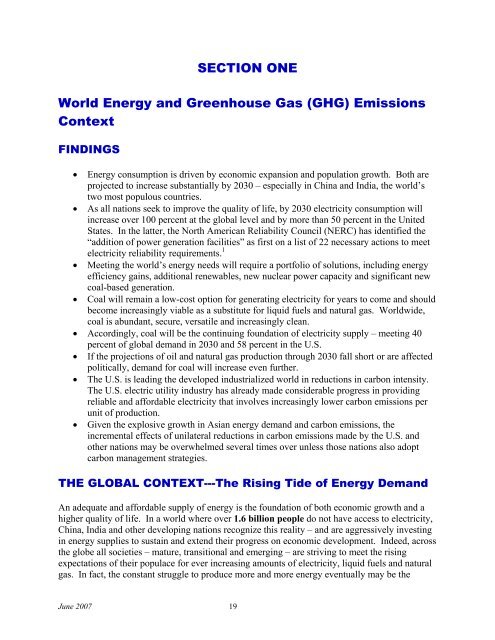Technologies to Reduce or Capture and Store Carbon Dioxide Emissions
TECHNOLOgIEs to Reduce or Capture and store Carbon Dioxide ...
TECHNOLOgIEs to Reduce or Capture and store Carbon Dioxide ...
Create successful ePaper yourself
Turn your PDF publications into a flip-book with our unique Google optimized e-Paper software.
SECTION ONE<br />
W<strong>or</strong>ld Energy <strong>and</strong> Greenhouse Gas (GHG) <strong>Emissions</strong><br />
Context<br />
FINDINGS<br />
• Energy consumption is driven by economic expansion <strong>and</strong> population growth. Both are<br />
projected <strong>to</strong> increase substantially by 2030 – especially in China <strong>and</strong> India, the w<strong>or</strong>ld’s<br />
two most populous countries.<br />
• As all nations seek <strong>to</strong> improve the quality of life, by 2030 electricity consumption will<br />
increase over 100 percent at the global level <strong>and</strong> by m<strong>or</strong>e than 50 percent in the United<br />
States. In the latter, the N<strong>or</strong>th American Reliability Council (NERC) has identified the<br />
“addition of power generation facilities” as first on a list of 22 necessary actions <strong>to</strong> meet<br />
electricity reliability requirements. 1<br />
• Meeting the w<strong>or</strong>ld’s energy needs will require a p<strong>or</strong>tfolio of solutions, including energy<br />
efficiency gains, additional renewables, new nuclear power capacity <strong>and</strong> significant new<br />
coal-based generation.<br />
• Coal will remain a low-cost option f<strong>or</strong> generating electricity f<strong>or</strong> years <strong>to</strong> come <strong>and</strong> should<br />
become increasingly viable as a substitute f<strong>or</strong> liquid fuels <strong>and</strong> natural gas. W<strong>or</strong>ldwide,<br />
coal is abundant, secure, versatile <strong>and</strong> increasingly clean.<br />
• Acc<strong>or</strong>dingly, coal will be the continuing foundation of electricity supply – meeting 40<br />
percent of global dem<strong>and</strong> in 2030 <strong>and</strong> 58 percent in the U.S.<br />
• If the projections of oil <strong>and</strong> natural gas production through 2030 fall sh<strong>or</strong>t <strong>or</strong> are affected<br />
politically, dem<strong>and</strong> f<strong>or</strong> coal will increase even further.<br />
• The U.S. is leading the developed industrialized w<strong>or</strong>ld in reductions in carbon intensity.<br />
The U.S. electric utility industry has already made considerable progress in providing<br />
reliable <strong>and</strong> aff<strong>or</strong>dable electricity that involves increasingly lower carbon emissions per<br />
unit of production.<br />
• Given the explosive growth in Asian energy dem<strong>and</strong> <strong>and</strong> carbon emissions, the<br />
incremental effects of unilateral reductions in carbon emissions made by the U.S. <strong>and</strong><br />
other nations may be overwhelmed several times over unless those nations also adopt<br />
carbon management strategies.<br />
THE GLOBAL CONTEXT---The Rising Tide of Energy Dem<strong>and</strong><br />
An adequate <strong>and</strong> aff<strong>or</strong>dable supply of energy is the foundation of both economic growth <strong>and</strong> a<br />
higher quality of life. In a w<strong>or</strong>ld where over 1.6 billion people do not have access <strong>to</strong> electricity,<br />
China, India <strong>and</strong> other developing nations recognize this reality – <strong>and</strong> are aggressively investing<br />
in energy supplies <strong>to</strong> sustain <strong>and</strong> extend their progress on economic development. Indeed, across<br />
the globe all societies – mature, transitional <strong>and</strong> emerging – are striving <strong>to</strong> meet the rising<br />
expectations of their populace f<strong>or</strong> ever increasing amounts of electricity, liquid fuels <strong>and</strong> natural<br />
gas. In fact, the constant struggle <strong>to</strong> produce m<strong>or</strong>e <strong>and</strong> m<strong>or</strong>e energy eventually may be the<br />
June 2007 19


